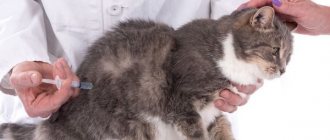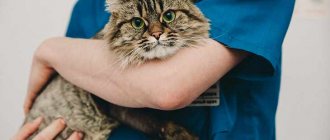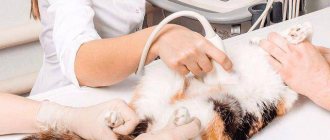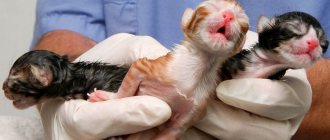In cats, spotting can be either normal or a sign of serious illness. In the first case, they accompany normal physiological processes, such as estrus or cleansing of the uterine cavity after childbirth. But if the discharge appears at the wrong time, causes discomfort to your pet and has a foul odor, you should consult a veterinarian as soon as possible. If this is not done, the animal may die.
So, how to distinguish normal discharge from pathological ones and how to treat a cat?
Reasons for appearance
Normally, bloody discharge appears in a cat for the following reasons:
- Estrus. The discharge indicates that the cat is ready to mate and bear offspring; its duration is several days. At the same time, the secretion does not have an unpleasant odor, and when the animal licks itself, it does not leave marks on surrounding objects. It is important to remember that spotting during estrus is typical for untied cats. After the first birth they will always be transparent.
- During pregnancy. Normally, during the entire period when a cat is bearing offspring, she should not be bothered by discharge. Ichor may be released during contractions.
- After the birth of kittens. The animal’s body is recovering, so during the first three weeks after birth, the presence of spotting is considered normal. In this case, the pet should feel well, eat as usual and carefully care for the offspring. If the discharge continues for more than the specified period, and the cat becomes lethargic, then it needs to be shown to a veterinarian.
A small amount of blood from the uterus can be released in cats only for the reasons described above. If the secretion is copious, foul-smelling, or includes particles, then this may be a symptom of many diseases of the genitourinary system or a sign of uterine bleeding.
Causes of bloody impurities in urine
A number of reasons can provoke inappropriate impurities:
- Bacterial infections;
- Helminthic infestations affecting the kidneys and bladder;
- Organ damage due to trauma;
- Poisoning;
- Heart diseases;
- Oncology;
Of course, in all unclear situations when it comes to a pet and its health, it is better to immediately consult a specialist. But there are times when it is simply not physically possible to quickly deliver a patient to a veterinary clinic. So what should you do if there is blood in your cat’s urine?
We recommend the article: What does a cat’s lack of appetite indicate?
Basic actions:
- Provide the animal with a quiet stay in a cozy, dry place where no one will disturb or tug at it.
- Place clean water nearby so that the cat does not have to walk far to quench its thirst.
- Feed with liquid food.
- To disinfect the urinary tract, give your pet decoctions of parsley or bearberry.
- To eliminate inflammatory processes, decoctions of horsetail and juniper will help well.
- Under no circumstances should you start giving your animal antibiotics or other medications before consulting with a specialist.
- If bleeding is heavy, ice should be used as a cold compress on the lower abdomen or sacrum.
Dangerous diseases
Cats may experience atypical bloody discharge, which is a symptom of the following diseases:
- endometritis and pyometra are infectious diseases in which the uterine mucosa becomes inflamed and begins to bleed;
- inflammatory processes in the genital organs - their causes are varied, ranging from stress to infection, often ending in cystitis;
- phlegmon - under the influence of unfavorable factors, the cat experiences swelling of the genitals and the formation of ulcers;
- vaginitis - inflammation of the vagina caused by infections or injuries after unsuccessful medical procedures;
- tumor process in the uterus - as a rule, it is malignant in nature, the animal experiences destruction of soft tissues;
- placenta in the uterus - if not all placenta came out during childbirth, this leads to an inflammatory process in the uterus;
- various injuries to the genital organs - most often the cause is a poorly performed operation, which leads to bleeding.
The diseases described above have many similar symptoms:
- the animal becomes lethargic and drowsy;
- the cat tries to hide from its owners and other pets and shows no interest in playing;
- food refusal is observed, the animal may not drink well;
- a secretion is released from the genital organs, which, depending on the pathology, can be foul-smelling, with traces of pus and particles of mucous membrane;
- blood loss continues for a long time without a tendency to stop;
- The animal's temperature rises and does not subside.
To find out what exactly your pet is sick with, you need to contact a veterinarian as soon as possible. Independent attempts to find out what exactly is happening with the cat will not only not lead to success, but will also lead to the loss of precious time.
Risks of the condition
Regular or large amounts of blood loss can weaken even the strongest organism, which cannot cope with bleeding on its own without outside intervention. Severe blood loss in a cat can result in the following:
A single bleed in a cat is not dangerous.
- disruption of mechanical circulatory function;
- insufficient filling of blood vessels and cardiac compartments with blood;
- falling blood pressure;
- a sharp decrease in red blood cells and a drop in hemoglobin levels leads to the development of anemia;
- tissue hypoxia (oxygen starvation) due to a disrupted process of oxygen transfer through vessels to tissues and organs;
- disruption of local metabolic processes, which leads to massive cell death, and then the death of the organism.
Treatment
Before starting to treat the animal, the doctor finds out the root cause of the discharge. This will require the following examinations:
- initial examination of the animal, careful palpation of the abdominal area;
- general and biochemical blood test, laboratory urine test;
- Ultrasound of internal organs;
- examination of the uterus using a colposcope;
- study of secretions;
- bacterial culture to identify the pathogen;
- biopsy of the mucous membranes of the genital organs.
Based on the research results, the doctor makes a diagnosis and prescribes the necessary medications and procedures.
Depending on the reason for the bleeding, the cat is prescribed the following treatment:
- Anti-shock therapy is carried out using painkillers.
- If your cat is bleeding heavily, a blood transfusion may be required.
- If the bleeding is caused by low blood clotting, then corrective therapy is prescribed.
- For pathologies such as tumors or endometritis, surgery followed by chemotherapy is indicated to reduce the risk of relapse.
- The animal is prescribed antibiotics when the disease is caused by pathogenic microorganisms.
All medications and their dosage can be prescribed and adjusted only by a veterinarian. Self-medication will not only not bring a positive result, but can also lead to the premature death of your pet.
Overt and hidden internal bleeding
Discharge from a pregnant cat: bloody, yellow
It is impossible to see internal bleeding in a cat. But some similar processes are manifested by certain external symptoms and are called overt internal bleeding.
Table of external symptoms of obvious internal bleeding:
| Type of obvious internal bleeding | Accompanying external symptoms |
| Esophageal | Vomiting with bright scarlet blood. |
| Gastric | Burgundy or brown clots of coagulated blood in the vomit. |
| Intestinal | Burgundy or brown clots of coagulated blood in vomit (small intestine) and/or stool with traces of dark blood or black in consistency like coffee grounds (lower intestines). |
| Pulmonary | Wet cough with bloody foam. |
| Royal | Bloody discharge from the loop. |
| Renal | Blood or traces of it in every urine sample. |
External symptom of obvious internal bleeding
Care, maintenance and treatment of your pet
In order for treatment measures to bring positive results more quickly, owners need to provide the cat with proper care:
- Provide a secluded place for the animal, put a disposable sheet on the bed and change it regularly when it gets dirty.
- The room where the sick cat is located must be warm and free of drafts, and it must be ventilated regularly.
- During treatment, it is forbidden to let your pet go outside; its communication with other pets should be limited.
- The cat must have constant access to drinking water. If the animal refuses to drink or is too weak, you need to give it water yourself using a syringe, after removing the needle.
- During the illness, the animal should receive nutritious and easily digestible food. These can be meat broths, to which chopped meat, fermented milk products, cereals and vegetables are added in small quantities. On the advice of a veterinarian, you can purchase special medicated food so that the animal gains strength faster.
To protect your pet from diseases that lead to bleeding, you must adhere to the following preventive measures:
- If the cat is not intended for breeding, it makes sense to sterilize the pet. This will protect her from many diseases that occur in the genitourinary system. After the procedure, the cat should be regularly shown to the veterinarian for an ultrasound, this will help to better monitor the animal’s health.
- Get all necessary vaccinations and antihelminthic treatment in a timely manner to maintain the body's defenses.
- For mating, choose a healthy male cat; the owners of the male must document this.
- When giving birth to a cat, use sterile consumables and thoroughly treat your hands with antiseptics.
- If any unusual discharge occurs, you should take your cat to the veterinarian as soon as possible.
The measures described above will help not only prevent the development of the disease, but also, if necessary, show the cat to a specialist as soon as possible without wasting time.
Bloody discharge accompanied by a significant deterioration in the animal’s condition is a formidable sign indicating the development of severe pathology. There is no need to try to find the cause on your own, but take the cat to the veterinary clinic as soon as possible for examination and treatment.
Cat bleeding from anus
Abnormal discharge may also begin from the anus. This happens to animals of both sexes. They can be seen in the tray (after the pet has emptied), on the tail, in places where the cat usually sleeps. Reasons why a cat bleeds from the anus:
- Gastrointestinal diseases. There are many diseases of the digestive system that cause
inflammation and bleeding in the intestines. Blood is observed not only under the tail, but also in the feces. Impurities of pus and an unpleasant odor may appear. - Cracks in the rectum or anus. If your cat suffers from constipation, he may develop fissures or even hemorrhoids. The anus area will be red and swollen.
- Oncology. Animals get cancer too. Malignant tumors cause pain and bleeding.
- Urolithiasis disease. More often observed in older animals. Blood mixes with urine. After each bowel movement, red spots remain in the tray. There are also leaks under the tail, staining the anus. In such cases, it is difficult to understand where exactly the discharge is coming from. The disease sometimes alternates between periods of exacerbation and remission.
- Injuries. A cat can damage the anus area in games or unsuccessful jumps. If he goes outside, he gets into fights. In such situations, abrasions, scratches, and bruises may be observed under the tail.
All of these diseases have other symptoms in addition to bleeding. The pet's appetite worsens and weight loss occurs. The animal looks lethargic and sleeps more restlessly. When cats are in pain, they take a “crooked” pose. If the pain is severe, the cat will show aggression, not even allowing its beloved owner to touch itself.
Features of the first heat
Established conditions for breeding purebred cats prescribe breeding mature animals no earlier than the first year of life. It is believed that during this period the formation is completed and there is a physiological opportunity for the birth of offspring.
For the first time this process usually begins at the age of 10-11 months, it is then that a female can be brought together with a male.
In fact, it all depends on the breed, temperament, health status and other individual characteristics. In some pets, the first discharge appears at 7-8 months, but knitting at this age is not recommended, the body is not yet ready for childbearing.
Often there is a problem of early estrus in a purebred cat, on which the breeders had great hopes. In this case, doctors advise removing the pet from breeding, since the problem can be inherited. In this case, veterinarians insist that the cat be sterilized.
However, if the owners of the animal are categorically against it, it is necessary to begin treatment with medications as early as possible in order to improve the hormonal balance and the functioning of all body systems.
Complications leading to bleeding after childbirth
Let's look at the symptom of what complication postpartum bleeding can be. Let's start with the reason mentioned above - incomplete expulsion of kittens or placenta.
Many inexperienced owners believe that the end of pushing indicates the completion of the birth process. However, if the cat was not examined by ultrasound during the last stage of pregnancy, the owner cannot know the exact number of kittens that were due to be born. In this case, there is a risk that a dead kitten or the placenta of the last born cub will remain in the uterine cavity.
With such complications, the first alarming symptoms appear within 24-72 hours after birth.
- The cat's appetite rapidly deteriorates, apathy appears, and as a result of painful sensations, the young mother abandons the kittens.
- Brown discharge with a small amount of coagulated blood appears from the cat's vagina.
- As complications develop, baseline body temperature constantly rises.
- When you palpate your cat's abdomen, you will find that the abdominal muscles are tense and she is reacting to pain.
If symptoms are detected in time and correctly interpreted, conservative treatment is used to resolve the situation. After stimulating additional pushing and cleaning the uterine cavity, the woman in labor is prescribed a course of broad-spectrum antibiotics to prevent the development of a bacterial infection. If more than a day has passed since the birth, the veterinarian will have to perform castration - remove the uterus.
What to pay attention to
Representatives of the cat family are very clean, so the owners of the animal may not immediately notice pathological discharge from the genitals. Indirect signs should alert you.
The first thing that arouses suspicion is that the cat often licks the perineum (every 15-20 minutes). Frequent urination is the second warning sign. Itching manifests itself as follows: the animal rubs its perineum on the floor or some objects. All indirect signs should force the owner to pay close attention to the pet.











